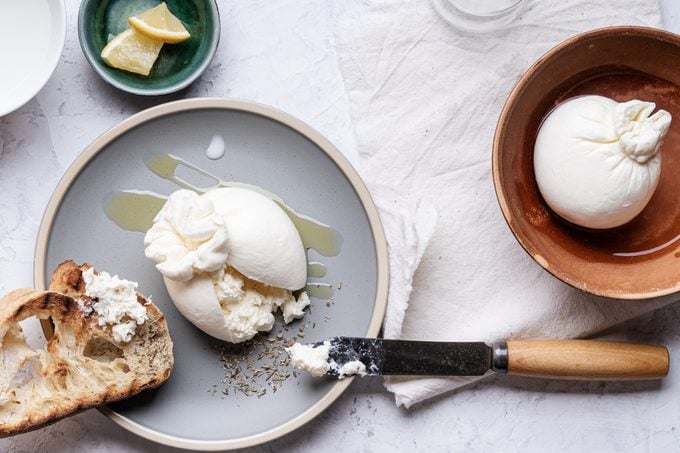Looking to amp up your cheese game with very little effort? Skip the fresh mozzarella—and use burrata instead!

What Is Burrata and How Is It Made?


I’ll never forget my first experience with burrata cheese. I was at a somewhat fancy farm-to-table restaurant (you know, the kind where they tell you where your chicken came from). We ordered several plates to share, including a caprese salad because tomatoes were in season. I wasn’t expecting to be wowed—how exciting can tomatoes, mozzarella and basil be?—until the dish arrived at the table. The thick-sliced heirloom tomatoes cascaded in an arc around a gigantic ball of burrata cheese, which oozed like a poached egg when we cut into it. It tasted like mozzarella and looked like mozzarella but with a serious upgrade: distinctly rich, buttery and creamy.
I was hooked. I started making burrata boards and serving the cheese with grilled fruits, salted meats or plain with good, old-fashioned crackers. An orb of burrata became a mainstay on top of creamy risottos, meaty pastas or luscious soups. I spread it on toast for breakfast or as a quick appetizer and tore the cheese into pieces to add to salads or roasted vegetables.
Ready to get started with this unique cheese? Learning about the best ways to eat burrata cheese (and which cooking methods you’ll want to avoid when using it) starts by understanding what is burrata cheese, and how it’s made.
What is burrata cheese?
Burrata translates from Italian to mean “buttered,” so you know it’s going to have a rich, creamy flavor! This cow’s milk cheese is similar to fresh mozzarella, except the shell is stuffed with shreds of cheese soaked in cream (a cheese called Stracciatella). It is pasteurized and tastes lightly sweet and buttery, but its texture is what makes the cheese really shine. The outer shell is smooth and chewy, while the interior is soft and gooey, providing a delightful contrast.
What is the difference between mozzarella and burrata?
Burrata cheese and mozzarella are related but differ in one important aspect: Mozzarella is shaped into a solid ball of cheese, whereas burrata’s outer shell is formed into a loose pouch. From there, the pouch is stuffed with creamy cheese, making it more like a cheese-filled dumpling than a cheese ball.
How is burrata cheese made?
Making burrata cheese starts with the same steps as mozzarella. Cow’s milk is heated and set with rennet, an enzyme that turns the liquid into curds and whey. The curds are warmed with boiling water until they’re soft and mailable enough to stretch. If this was mozzarella, the cheesemakers would form the stretched curds into balls and let them cool in salted water or whey.
With burrata, some of the stretched curds are turned into Stracciatella, which means they’re left as strands and soaked in cream. Others are formed into a loose pouch to form a shell. After the creamy strands are stuffed inside the shell, it’s formed into a ball, sealed and stored in whey.
How do you eat burrata? 5 Tips for Serving Burrata Cheese
Let it come to room temperature
Cold temperatures have a way of muting flavors, so you’ll want to take the chill off burrata to achieve its best taste. This is as easy are removing the burrata from the refrigerator about 30 minutes before serving.
Don’t keep it for too long
Burrata is best right after it’s made, so only keep it in the refrigerator for a short time. Plan on using it the same day you purchase it, or the next day at most, as the flavor begins to sour after a few days. Store it in the liquid it came in, too. If you accidentally drained the container, you can store burrata in tap water.
Unfortunately, this isn’t a cheese you can freeze when it’s near its expiration. The high water content crystallizes when frozen, destroying the texture.
Cut burrata just before serving
Once you cut into a burrata ball, the gooey center will begin to seep out, so cut burrata needs to be eaten immediately. Serve it by placing the whole ball on the center of the dish and cutting into it at the table. Alternatively, you can cut the orb into small cubes or tear it into strips before adding it your recipe.
Avoid melting it
Burrata is special because of the textural difference between its soft shell and the gooey center inside. It tastes melty even when it’s served at room temperature. You can warm it lightly, but avoid completely melting it or you’ll miss out on experiencing those unique qualities. Stick to fresh mozzarella for melted applications and use burrata as a finishing cheese instead.
Serve it simply
You won’t want to overpower burrata cheese with a ton of sauces, herbs or spices. This cheese shines because of its mild but rich flavor, and peppering it with a ton of spices would take away from its delicate aesthetic. Of course, you will see burrata used as a garnish on dishes with rich tomato sauces and herbaceous pestos, so this isn’t a hard and fast rule.
When we’re serving burrata as an appetizer or on a charcuterie board, we like to season it simply with a drizzle of high-quality olive oil and a sprinkle of sea salt.



















